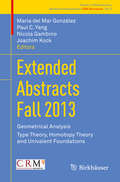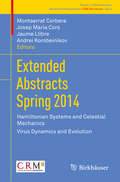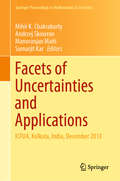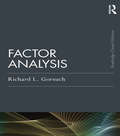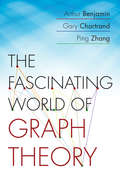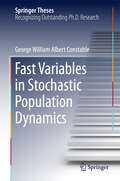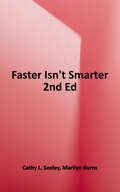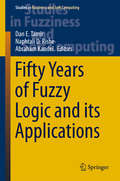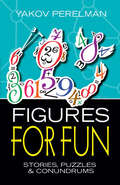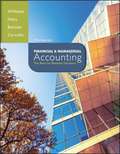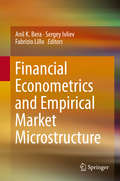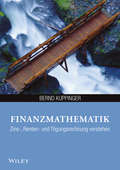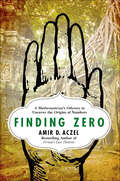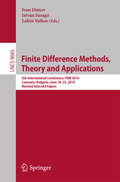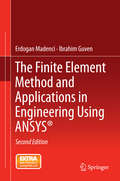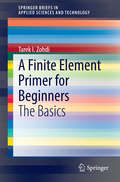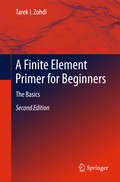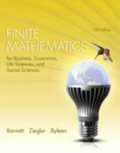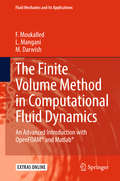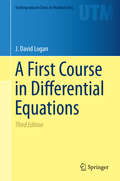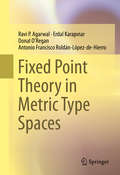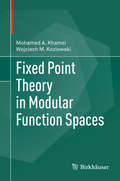- Table View
- List View
Extended Abstracts Fall 2013
by Maria del Mar González Paul C. Yang Nicola Gambino Joachim KockThe two parts of the present volume contain extended conference abstracts corresponding to selected talks given by participants at the "Conference on Geometric Analysis" (thirteen abstracts) and at the "Conference on Type Theory, Homotopy Theory and Univalent Foundations" (seven abstracts), both held at the Centre de Recerca Matemàtica (CRM) in Barcelona from July 1st to 5th, 2013, and from September 23th to 27th, 2013, respectively. Most of them are brief articles, containing preliminary presentations of new results not yet published in regular research journals. The articles are the result of a direct collaboration between active researchers in the area after working in a dynamic and productive atmosphere. The first part is about Geometric Analysis and Conformal Geometry; this modern field lies at the intersection of many branches of mathematics (Riemannian, Conformal, Complex or Algebraic Geometry, Calculus of Variations, PDE's, etc) and relates directly to the physical world, since many natural phenomena posses an intrinsic geometric content. The second part is about Type Theory, Homotopy Theory and Univalent Foundations. The book is intended for established researchers, as well as for PhD and postdoctoral students who want to learn more about the latest advances in these highly active areas of research.
Extended Abstracts Spring 2014
by Montserrat Corbera Josep Maria Cors Jaume Llibre Andrei KorobeinikovThe two parts of the present volume contain extended conference abstracts corresponding to selected talks given by participants at the "Conference on Hamiltonian Systems and Celestial Mechanics 2014" (HAMSYS2014) (15 abstracts) and at the "Workshop on Virus Dynamics and Evolution" (12 abstracts), both held at the Centre de Recerca Matemàtica (CRM) in Barcelona from June 2nd to 6th, 2014, and from June 23th to 27th, 2014, respectively. Most of them are brief articles, containing preliminary presentations of new results not yet published in regular research journals. The articles are the result of a direct collaboration between active researchers in the area after working in a dynamic and productive atmosphere. The first part is about Central Configurations, Periodic Orbits and Hamiltonian Systems with applications to Celestial Mechanics - a very modern and active field of research. The second part is dedicated to mathematical methods applied to viral dynamics and evolution. Mathematical modelling of biological evolution currently attracts the interest of both mathematicians and biologists. This material offers a variety of new exciting problems to mathematicians and reasonably inexpensive mathematical methods to evolutionary biologists. It will be of scientific interest to both communities. The book is intended for established researchers, as well as for PhD and postdoctoral students who want to learn more about the latest advances in these highly active areas of research.
Facets of Uncertainties and Applications
by Mihir K. Chakraborty Andrzej Skowron Manoranjan Maiti Samarjit KarSince the emergence of the formal concept of probability theory in the seventeenth century, uncertainty has been perceived solely in terms of probability theory. However, this apparently unique link between uncertainty and probability theory has come under investigation a few decades back. Uncertainties are nowadays accepted to be of various kinds. Uncertainty in general could refer to different sense like not certainly known, questionable, problematic, vague, not definite or determined, ambiguous, liable to change, not reliable. In Indian languages, particularly in Sanskrit-based languages, there are other higher levels of uncertainties. It has been shown that several mathematical concepts such as the theory of fuzzy sets, theory of rough sets, evidence theory, possibility theory, theory of complex systems and complex network, theory of fuzzy measures and uncertainty theory can also successfully model uncertainty.
Factor Analysis: Classic Edition (Psychology Press & Routledge Classic Editions)
by Richard L. GorsuchComprehensive and comprehensible, this classic text covers the basic and advanced topics essential for using factor analysis as a scientific tool in psychology, education, sociology, and related areas. Emphasizing the usefulness of the techniques, it presents sufficient mathematical background for understanding and applying its use. This includes the theory as well as the empirical evaluations. The overall goal is to show readers how to use factor analysis in their substantive research by highlighting when the differences in mathematical procedures have a major impact on the substantive conclusions, when the differences are not relevant, and when factor analysis might not be the best procedure to use. Although the original version was written years ago, the book maintains its relevance today by providing readers with a thorough understanding of the basic mathematical models so they can easily apply these models to their own research. Readers are presented with a very complete picture of the "inner workings" of these methods. The new Introduction highlights the remarkably few changes that the author would make if he were writing the book today. An ideal text for courses on factor analysis or as a supplement for multivariate analysis, structural equation modeling, or advanced quantitative techniques taught in psychology, education, and other social and behavioral sciences, researchers who use these techniques also appreciate this book’s thorough review of the basic models. Prerequisites include a graduate level course on statistics and a basic understanding of algebra. Sections with an asterisk can be skipped entirely if preferred.
Family Issues on Marriage, Divorce, and Older Adults in Japan
by Fumie KumagaiThis book provides insightful sociological analyses of Japanese demography and families, paying attention not only to national average data, but also to regional variations and community level analyses. In analyzing Japanese family issues such as demographic changes, courtship and marriage, international marriage, divorce, late-life divorce, and the elderly living alone, this book emphasizes the significance of two theoretical frameworks: the dual structure and regional variations of the community network in Japan. By emphasizing the extensive cultural diversity from one region to another, this book represents a paradigm shift from former studies of Japanese families, which relied mostly on national average data. The method of analysis adopted in the study is qualitative, with a historical perspective. The book is thus an invitation to more in-depth, qualitative dialogue in the field of family sociology in Japan. This book will be of great interest not only to Asian scholars, but also to other specialists in comparative family studies around the world.
The Fascinating World of Graph Theory
by Arthur Benjamin Ping Zhang Gary ChartrandThe fascinating world of graph theory goes back several centuries and revolves around the study of graphs--mathematical structures showing relations between objects. With applications in biology, computer science, transportation science, and other areas, graph theory encompasses some of the most beautiful formulas in mathematics--and some of its most famous problems. For example, what is the shortest route for a traveling salesman seeking to visit a number of cities in one trip? What is the least number of colors needed to fill in any map so that neighboring regions are always colored differently? Requiring readers to have a math background only up to high school algebra, this book explores the questions and puzzles that have been studied, and often solved, through graph theory. In doing so, the book looks at graph theory's development and the vibrant individuals responsible for the field's growth.Introducing graph theory's fundamental concepts, the authors explore a diverse plethora of classic problems such as the Lights Out Puzzle, the Minimum Spanning Tree Problem, the Königsberg Bridge Problem, the Chinese Postman Problem, a Knight's Tour, and the Road Coloring Problem. They present every type of graph imaginable, such as bipartite graphs, Eulerian graphs, the Petersen graph, and trees. Each chapter contains math exercises and problems for readers to savor.An eye-opening journey into the world of graphs, this book offers exciting problem-solving possibilities for mathematics and beyond.
Fast Variables in Stochastic Population Dynamics
by George William Albert ConstableIn this thesis two variants of the fast variable elimination method are developed. They are intuitive, simple to implement and give results which are in very good agreement with those found from numerical simulations. The relative simplicity of the techniques makes them ideal for applying to problems featuring demographic stochasticity, for experts and non-experts alike. Within the context of mathematical modelling, fast variable elimination is one of the central tools with which one can simplify a multivariate problem. When used in the context of of deterministic systems, the theory is quite standard, but when stochastic effects are present, it becomes less straightforward to apply. While the introductory and background chapters form an excellent primer to the theory of stochastic population dynamics, the techniques developed can be applied to systems exhibiting a separation of timescales in a variety of fields including population genetics, ecology and epidemiology.
Faster Isn't Smarter: Messages about Math, Teaching, and Learning in the 21st Century
by Cathy L. SeeleyFeaturing 41 entirely updated messages and four new ones, this second edition continues to offer straight talk and common sense about some of today's most important, thought-provoking issues in education. With themes ranging from equity, intelligence, and the incredible potential of all students to challenging students to think with a problem-centered approach focused on student engagement and classroom discourse, the book provides a base for lively discussion among elementary, middle, and high school teachers; leaders; policymakers; and families. Entirely updated, including new messages.
Fifty Years of Fuzzy Logic and its Applications
by Dan E. Tamir Naphtali D. Rishe Abraham KandelThis book presents a comprehensive report on the evolution of Fuzzy Logic since its formulation in Lotfi Zadeh's seminal paper on "fuzzy sets," published in 1965. In addition, it features a stimulating sampling from the broad field of research and development inspired by Zadeh's paper. The chapters, written by pioneers and prominent scholars in the field, show how fuzzy sets have been successfully applied to artificial intelligence, control theory, inference, and reasoning. The book also reports on theoretical issues; features recent applications of Fuzzy Logic in the fields of neural networks, clustering, data mining and software testing; and highlights an important paradigm shift caused by Fuzzy Logic in the area of uncertainty management. Conceived by the editors as an academic celebration of the fifty years' anniversary of the 1965 paper, this work is a must-have for students and researchers willing to get an inspiring picture of the potentialities, limitations, achievements and accomplishments of Fuzzy Logic-based systems.
Figures for Fun: Stories, Puzzles and Conundrums
by Yakov Perelman"Does your brain need a workout? Are you wondering what to do? Well this could be the book for you! This is a great book for anyone who is looking for a challenge and, if you get too stuck, the author kindly also provided the answers at the end of each chapter!" -- Splashes Into BooksGive your mind a playful workout with this collection of more than 100 inventive puzzles. Finding the solutions requires only minimal mathematical knowledge and will test your imagination as well as your brainpower. The motley collection ranges from conundrums and mathematical stunts to practical situations involving counting and measuring. Chess problems, magic squares, and a host of other intriguing scenarios will amuse and challenge puzzle enthusiasts and fans of recreational mathematics. Answers appear at the end of each chapter.These puzzles are the inventions of a gifted Soviet mathematician, Yakov Perelman, whose popular science books on astronomy, physics, and mathematics inspired generations of readers. Perelman's distinctive style, abounding in wit and ingenuity, adds a special flair to his timeless riddles and brainteasers.
Financial and Managerial Accounting (Seventeenth Edition)
by Jan Williams Joseph Carcello Mark Bettner Susan HakaWith the seventeenth edition of Financial and Managerial Accounting: The Basis for Business Decisions, the Williams author team continues to be a solid foundation for students who are learning basic accounting concepts. Hallmarks of the text - including the solid Accounting Cycle Presentation, relevant pedagogy, and high quality, end-of-chapter material--have been updated throughout the book.
Financial Econometrics and Empirical Market Microstructure
by Anil K. Bera Sergey Ivliev Fabrizio LilloIn the era of Big Data our society is given the unique opportunity to understand the inner dynamics and behavior of complex socio-economic systems. Advances in the availability of very large databases, in capabilities for massive data mining, as well as progress in complex systems theory, multi-agent simulation and computational social science open the possibility of modeling phenomena never before successfully achieved. This contributed volume from the Perm Winter School address the problems of the mechanisms and statistics of the socio-economics system evolution with a focus on financial markets powered by the high-frequency data analysis.
Finanzmathematik: Zins-, Renten- und Tilgungsrechnung verstehen (Studienbücher Wirtschaftsmathematik Ser.)
by Bernd KuppingerDie Finanzmathematik ist unter Wirtschaftswissenschaftlern nicht immer beliebt. Sie gilt als kompliziert und recht lernintensiv. Bernd Kuppinger will Ihnen in diesem Buch zeigen, dass das nicht so sein muss. Er erklärt Ihnen so verständlich wie möglich, was Sie über Zins-, Renten- und Tilgungsrechnung wissen müssen. Er gibt eine Einführung in die Investitionsrechnung und bringt Ihnen in einem eigenen Teil auch noch das mathematische Handwerkszeug näher, das Sie brauchen, um in der Finanzmathematik zu bestehen. Viele Beispiele helfen Ihnen, den Bezug zur Praxis herzustellen, und mit den zahlreichen Übungsaufgaben können Sie Ihr Wissen festigen und testen.
Finding Zero: A Mathematician's Odyssey to Uncover the Origins of Numbers
by Amir D. AczelThe invention of numerals is perhaps the greatest abstraction the human mind has ever created. Virtually everything in our lives is digital, numerical, or quantified. The story of how and where we got these numerals, which we so depend on, has for thousands of years been shrouded in mystery. Finding Zero is an adventure filled saga of Amir Aczel's lifelong obsession: to find the original sources of our numerals. Aczel has doggedly crisscrossed the ancient world, scouring dusty, moldy texts, cross examining so-called scholars who offered wildly differing sets of facts, and ultimately penetrating deep into a Cambodian jungle to find a definitive proof. Here, he takes the reader along for the ride. The history begins with the early Babylonian cuneiform numbers, followed by the later Greek and Roman letter numerals. Then Aczel asks the key question: where do the numbers we use today, the so-called Hindu-Arabic numerals, come from? It is this search that leads him to explore uncharted territory, to go on a grand quest into India, Thailand, Laos, Vietnam, and ultimately into the wilds of Cambodia. There he is blown away to find the earliest zero—the keystone of our entire system of numbers—on a crumbling, vine-covered wall of a seventh-century temple adorned with eaten-away erotic sculptures. While on this odyssey, Aczel meets a host of fascinating characters: academics in search of truth, jungle trekkers looking for adventure, surprisingly honest politicians, shameless smugglers, and treacherous archaeological thieves—who finally reveal where our numbers come from.
Finite Difference Methods,Theory and Applications
by Ivan Dimov István Faragó Lubin VulkovThis book constitutes the thoroughly refereed post-conference proceedings of the 6th International Conference on Finite Difference Methods, FDM 2014, held in Lozenetz, Bulgaria, in June 2014. The 36 revised full papers were carefully reviewed and selected from 62 submissions. These papers together with 12 invited papers cover topics such as finite difference and combined finite difference methods as well as finite element methods and their various applications in physics, chemistry, biology and finance.
The Finite Element Method and Applications in Engineering Using ANSYS®
by Ibrahim Guven Erdogan MadenciThis textbook offers theoretical and practical knowledge of the finite element method. The book equips readers with the skills required to analyze engineering problems using ANSYS®, a commercially available FEA program. Revised and updated, this new edition presents the most current ANSYS® commands and ANSYS® screen shots, as well as modeling steps for each example problem. This self-contained, introductory text minimizes the need for additional reference material by covering both the fundamental topics in finite element methods and advanced topics concerning modeling and analysis. It focuses on the use of ANSYS® through both the Graphics User Interface (GUI) and the ANSYS® Parametric Design Language (APDL). Extensive examples from a range of engineering disciplines are presented in a straightforward, step-by-step fashion. Key topics include: * An introduction to FEM * Fundamentals and analysis capabilities of ANSYS® * Fundamentals of discretization and approximation functions * Modeling techniques and mesh generation in ANSYS® * Weighted residuals and minimum potential energy * Development of macro files * Linear structural analysis * Heat transfer and moisture diffusion * Nonlinear structural problems * Advanced subjects such as submodeling, substructuring, interaction with external files, and modification of ANSYS®-GUI Supplementary materials for this book may be downloaded from http://extras. springer. com. This convenient online feature, which includes color figures, screen shots and input files for sample problems, allows for regeneration on the reader's own computer. Students, researchers, and practitioners alike will find this an essential guide to predicting and simulating the physical behavior of complex engineering systems.
A Finite Element Primer for Beginners: The Basics (SpringerBriefs in Applied Sciences and Technology)
by Tarek I. ZohdiThe purpose of this primer is to provide the basics of the Finite Element Method, primarily illustrated through a classical model problem, linearized elasticity. The topics covered are: (1) Weighted residual methods and Galerkin approximations, (2) A model problem for one-dimensional linear elastostatics, (3) Weak formulations in one dimension, (4) Minimum principles in one dimension, (5) Error estimation in one dimension, (5) Construction of Finite Element basis functions in one dimension, (6) Gaussian Quadrature, (7) Iterative solvers and element by element data structures, (8) A model problem for three-dimensional linear elastostatics, (9) Weak formulations in three dimensions, (10) Basic rules for element construction in three-dimensions, (11) Assembly of the system and solution schemes, (12) Assembly of the system and solution schemes, (13) An introduction to time-dependent problems and (14) A brief introduction to rapid computation based on domain decomposition and basic parallel processing.
A Finite Element Primer for Beginners: The Basics (SpringerBriefs in Applied Sciences and Technology)
by Tarek I. ZohdiThe purpose of this primer is to provide the basics of the Finite Element Method, primarily illustrated through a classical model problem, linearized elasticity. The topics covered are: (1) Weighted residual methods and Galerkin approximations, (2) A model problem for one-dimensional linear elastostatics, (3) Weak formulations in one dimension, (4) Minimum principles in one dimension, (5) Error estimation in one dimension, (5) Construction of Finite Element basis functions in one dimension, (6) Gaussian Quadrature, (7) Iterative solvers and element by element data structures, (8) A model problem for three-dimensional linear elastostatics, (9) Weak formulations in three dimensions, (10) Basic rules for element construction in three-dimensions, (11) Assembly of the system and solution schemes, (12) Assembly of the system and solution schemes, (13) An introduction to time-dependent problems and (14) A brief introduction to rapid computation based on domain decomposition and basic parallel processing.
Finite Geometry and Combinatorial Applications
by Simeon BallThe projective and polar geometries that arise from a vector space over a finite field are particularly useful in the construction of combinatorial objects, such as latin squares, designs, codes and graphs. This book provides an introduction to these geometries and their many applications to other areas of combinatorics. Coverage includes a detailed treatment of the forbidden subgraph problem from a geometrical point of view, and a chapter on maximum distance separable codes, which includes a proof that such codes over prime fields are short. The author also provides more than 100 exercises (complete with detailed solutions), which show the diversity of applications of finite fields and their geometries. Finite Geometry and Combinatorial Applications is ideal for anyone, from a third-year undergraduate to a researcher, who wishes to familiarise themselves with and gain an appreciation of finite geometry.
Finite Mathematics for Business, Economics, Life Sciences, and Social Sciences (Thirteenth Edition)
by Raymond A. Barnett Michael R. Ziegler Karl E. ByleenLearn about the math that will help you in many careers and academic disciplines.
The Finite Volume Method in Computational Fluid Dynamics
by F. Moukalled L. Mangani M. DarwishThis textbook explores both the theoretical foundation of the Finite Volume Method (FVM) and its applications in Computational Fluid Dynamics (CFD). Readers will discover a thorough explanation of the FVM numerics and algorithms used for the simulation of incompressible and compressible fluid flows, along with a detailed examination of the components needed for the development of a collocated unstructured pressure-based CFD solver. Two particular CFD codes are explored. The first is uFVM, a three-dimensional unstructured pressure-based finite volume academic CFD code, implemented within Matlab. The second is OpenFOAM®, an open source framework used in the development of a range of CFD programs for the simulation of industrial scale flow problems. With over 220 figures, numerous examples and more than one hundred exercise on FVM numerics, programming, and applications, this textbook is suitable for use in an introductory course on the FVM, in an advanced course on numerics, and as a reference for CFD programmers and researchers.
A First Course in Differential Equations (Undergraduate Texts in Mathematics)
by J. David LoganThe third edition of this concise, popular textbook on elementary differential equations gives instructors an alternative to the many voluminous texts on the market. It presents a thorough treatment of the standard topics in an accessible, easy-to-read, format. The overarching perspective of the text conveys that differential equations are about applications. This book illuminates the mathematical theory in the text with a wide variety of applications that will appeal to students in physics, engineering, the biosciences, economics and mathematics. Instructors are likely to find that the first four or five chapters are suitable for a first course in the subject. This edition contains a healthy increase over earlier editions in the number of worked examples and exercises, particularly those routine in nature. Two appendices include a review with practice problems, and a MATLAB® supplement that gives basic codes and commands for solving differential equations. MATLAB® is not required; students are encouraged to utilize available software to plot many of their solutions. Solutions to even-numbered problems are available on springer. com. From the reviews of the second edition: "The coverage of linear systems in the plane is nicely detailed and illustrated. . . . Simple numerical methods are illustrated and the use of Maple and MATLAB is encouraged. . . . select Dave Logan's new and improved text for my course. " --Robert E. O'Malley, Jr. , SIAM Review, Vol. 53 (2), 2011 "Aims to provide material for a one-semester course that emphasizes the basic ideas, solution methods, and an introduction to modeling. . . . The book that results offers a concise introduction to the subject for students of mathematics, science and engineering who have completed the introductory calculus sequence. . . . This book is worth a careful look as a candidate text for the next differential equations course you teach. " --William J. Satzer, MAA Reviews, January, 2011
Fixed Point Theory in Metric Type Spaces
by Ravi P. Agarwal Erdal Karapınar Donal O'Regan Antonio Francisco Roldán-López-de-HierroWritten by a team of leading experts in the field, this volume presents a self-contained account of the theory, techniques and results in metric type spaces (in particular in G-metric spaces); that is, the text approaches this important area of fixed point analysis beginning from the basic ideas of metric space topology. The text is structured so that it leads the reader from preliminaries and historical notes on metric spaces (in particular G-metric spaces) and on mappings, to Banach type contraction theorems in metric type spaces, fixed point theory in partially ordered G-metric spaces, fixed point theory for expansive mappings in metric type spaces, generalizations, present results and techniques in a very general abstract setting and framework. Fixed point theory is one of the major research areas in nonlinear analysis. This is partly due to the fact that in many real world problems fixed point theory is the basic mathematical tool used to establish the existence of solutions to problems which arise naturally in applications. As a result, fixed point theory is an important area of study in pure and applied mathematics and it is a flourishing area of research.
Fixed Point Theory in Modular Function Spaces
by Mohamed A. Khamsi Wojciech M. KozlowskiThis monograph provides a concise introduction to the main results and methods of the fixed point theory in modular function spaces. Modular function spaces are natural generalizations of both function and sequence variants of many important spaces like Lebesgue, Orlicz, Musielak-Orlicz, Lorentz, Orlicz-Lorentz, Calderon-Lozanovskii spaces, and others. In most cases, particularly in applications to integral operators, approximation and fixed point results, modular type conditions are much more natural and can be more easily verified than their metric or norm counterparts. There are also important results that can be proved only using the apparatus of modular function spaces. The material is presented in a systematic and rigorous manner that allows readers to grasp the key ideas and to gain a working knowledge of the theory. Despite the fact that the work is largely self-contained, extensive bibliographic references are included, and open problems and further development directions are suggested when applicable. The monograph is targeted mainly at the mathematical research community but it is also accessible to graduate students interested in functional analysis and its applications. It could also serve as a text for an advanced course in fixed point theory of mappings acting in modular function spaces.
Florida Go Math: Mathematics 2
by Edward B. Burger Juli K. Dixon Timothy D. Kanold Matthew R. Larson Steven J. Leinwand Martha E. Sandoval-MartinezStandards for Mathematical Practice. The topics described in the Standards for Mathematical Content will vary from year to year. However, the way in which you learn, study, and think about mathematics will not. The Standards for Mathematical Practice describe skills that you will use in all of your math courses. These pages show some features of your book that will help you gain these skills and use them to master this year's topics.
